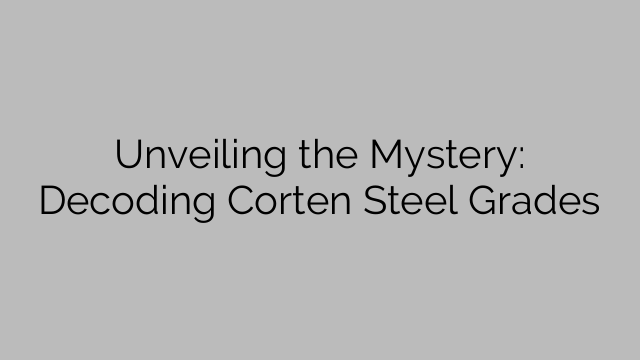Firstly, it is important to understand the composition of Corten steel. Corten steel is a group of steel alloys that contain copper, chromium, nickel, and phosphorus. These elements contribute to the formation of a protective patina on the surface of the steel when exposed to the atmosphere. This patina acts as a barrier, preventing the steel from further corrosion and giving it its distinct reddish-brown appearance.
Now, let’s unravel the mystery behind Corten steel grades. The most commonly used grades of Corten steel are ASTM A588 and ASTM A242. These grades are often designated as high-strength low-alloy (HSLA) steels, which means they possess high tensile strength while still being relatively lightweight. Additionally, they have excellent resistance to atmospheric corrosion, making them suitable for outdoor applications.
ASTM A588 is a high-strength, low-alloy structural steel grade with enhanced corrosion resistance. It is the most commonly used Corten steel grade in architectural applications and is often specified for building facades, bridges, and outdoor sculptures. ASTM A588 has a minimum yield strength of 50,000 psi and a minimum tensile strength of 70,000 psi.
On the other hand, ASTM A242 is a high-strength, low-alloy structural steel grade that is primarily used in applications where weight reduction and increased corrosion resistance are essential. Compared to ASTM A588, ASTM A242 has a slightly lower yield strength of 46,000 psi but a higher tensile strength of 63,000 psi.
Apart from these two primary grades, Corten steel also offers other grades such as ASTM A606, often referred to as weathering steel sheet and coil. This grade is commonly used for cladding, roofing, and decorative applications due to its improved formability and aesthetic appeal. It has a minimum yield strength of 50,000 psi and a minimum tensile strength of 70,000 psi, similar to ASTM A588.
In conclusion, Corten steel grades play a crucial role in determining the suitability of the steel for various applications. Whether it is ASTM A588 or ASTM A242, each grade offers its own set of properties and characteristics, allowing architects and designers to choose the most suitable option based on their project requirements. Understanding the different Corten steel grades allows for better decision-making and ensures the use of the right material for enhancing aesthetics and durability. With its unique rust-like appearance and impressive weather resistance, Corten steel grades continue to add a touch of intrigue and beauty to architectural designs worldwide.
[ad_2]

